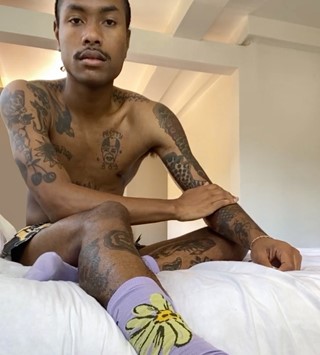At the brand’s Autumn/Winter 2020 show in Milan yesterday, the designer envisaged a working uniform for the new decade
- TextJack Moss
The setting for Prada’s latest menswear collection, shown in Milan yesterday, was an Italian piazza – or, at least, a simulacrum of one, a sparse imagining of a town square, reminiscent in colour and style of Giorgio de Chirico’s metaphysical paintings (in particular, his decade-spanning Piazza d’Italia series). At the centre, raised on a plinth, was a statue of horse and rider – a longtime symbol of heroic machismo, from ancient Greece onwards – though here not in solid bronze or marble, but thick white cardboard, slotted together like a child’s balsa-wood model of a dinosaur.
It might be easy to read this as simply a comment on the tenability of modern masculinity (ie: flimsy), but with Miuccia Prada it is never quite so literal. Out began the trail of models, watched on from the audience who sat above as if looking out from a window, each one dressed for work: neat sweater vests; optically patterned shirts and narrow ties; chromatic three-piece suits, shoulders sloped; colourful briefcases and pochettes the size of a laptop case. There were sleek mackintosh jackets, too – pockets emblazoned with tech-y Prada logos – and brilliant double-breasted crombies, in dizzy green check, black, or patent shearling. “Techno-classicism”, the notes explained.
Backstage, Miuccia Prada talked about work, too: in a climate of particularly disorientating current affairs, she reasoned, “the only thing that makes me calm, relaxed and optimistic is to give value to work”. She had been particularly fascinated with the Secession Movement, formed in 1897 in Vienna, which included artist Gustav Klimt and designer Josef Hoffmann, among others. Formed to counter the conservatism of Austria’s institutions, it valued pluralism and internationalism, finding ways of working together to push art and design forward. As Miuccia Prada explained, a time “when ideas, creativity, and actual work had to be all together”.

Was this the designer’s blueprint for the future, too? Or, indeed, the present? It is increasingly the way she sees herself working, an ever-challenging balance of ideas and creativity; of reshaping the way in which her own namesake company forges forward into the future. Like the topic of sustainability, she offered, which requires both technical know-how and creativity at once. “Everyone talks about sustainability,” she said. “Every time I do something, everyone asks, ‘Is it sustainable?’ It’s incredible how in one year it’s become a normal thing, so I’m very optimistic at the moment.”
The designer is well aware of the value of hard work; for over four decades she has steered the brand through a changing world, a venerative example of what can be gained by fearlessly treading your own path. “I want to give a hope that in this chaotic world,” she surmised, “if you do well your job, paired with intelligence, and with culture, then this already is something... It’s to give respect to work, to effort, to fatigue, and to what is difficult.”















